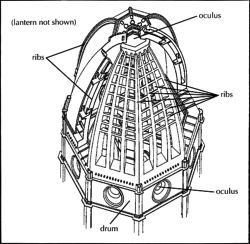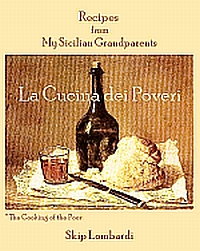Peposo alla Fornicina
December 7th, 2007
We’re in the midst of reviewing a new book on the history of the spice trade, The Taste of Conquest. Author Michael Krondl’s entertaining scholarship highlights pepper—once such a precious commodity that it was used as actual currency. This brings to mind the history of a Tuscan stew, Peposo. Numerous sources attribute its origins to the 1430’s, when the architect Filipo Brunelleschi was supervising construction of his dome on La Chiesa Santa Maria della Fiore, the famous Duomo in Florence.
The recipe is unremarkable. Then and now, it epitomizes Tuscan cuisine—local ingredients simply prepared: beef, garlic, red wine, and salt. However, one ingredient was anything but local. Giving the dish its name and distinctive bite is an unusually generous quantity of black pepper. Even more than the quantity of meat (Tuscany is famous for its Chianina beef-cattle), it was the pepper that would have made this dish deluxe in the 15th century. It is quite likely that Cosimo de Medici, art patron and the Duomo’s financier, was paying a portion of Brunelleschi’s (and perhaps even the workers’) wages in spice. The fact that medieval medicine deemed black pepper to be a “hot” and invigorating element would have been yet another reason to include it in the workers’ meals.
At the end of the work day on the Duomo, the ingredients for Peposo were sealed in a clay vessel and placed in the kiln which, during the day, had fired the terra cotta tiles for the dome. Overnight, the residual heat cooked the stew, hence its colloquial name, Peposo Notturno, Nocturnal Peposo. The following day, runners would shuttle bowls of stew up to the tile-workers on the dome. The roofers seemed to like the stew well enough, but the notion of spending their lunch hour on the dome—depriving them of the chance to play a few friendly hands of Scopa and quaff some vino on the ground—didn’t go over well at all, causing a small rebellion that may have amounted to Italy’s first labor strike.
Credit for the original Peposo recipe is claimed by nearly every town near Florence that had tile-making operations. Among those are Pistoia, Impruneta, and even La Spezia, in the province of Liguria. All these towns also insist that Dottore Brunelleschi visited each of them to select his tiles.
Over time, cooks have embellished the dish with tomatoes, mushrooms, and onions. One thing is certain: Brunelleschi’s stew could not have included tomatoes. That New World oddity didn’t appear in Italy until the mid-16th century.
By tradition, Tuscans serve Peposo over polenta or crostini, toasted bread. Contemporary Tuscans also serve peposo over mashed potatoes—another post-Columbus ingredient.
Peposo alla Fornicina
Beef Stew, Kiln-Worker’s Style
Ingredients:
2 Lb. Beef stew meat, cut into bite-sized chunks
10 Cloves garlic, peeled, but left whole
1 – 2 Tbs. Crushed black peppercorns
3 – 4 Cups dry red wine
Salt
4 Slices rustic bread (at least 1″ thick)
1 Clove garlic, peeled and halved
Preparation:
Pre-heat the oven to 250° F.
Place the meat and garlic in an ovenproof casserole. Sprinkle the crushed peppercorns over all. Add enough red wine to cover the meat by approximately one inch.
Bring the casserole to a simmer on the stove, then cover, and place the casserole in the center of the pre-heated oven. Cook, adjusting the heat so the stew barely bubbles, for approximately 6 hours. If the liquid reduces too much while the stew cooks, add hot water to compensate.
At the end of cooking, the sauce should be thick enough to coat a spoon, and the meat should be falling apart. If necessary, simmer the stew, uncovered on the stovetop, to reduce the sauce further. Taste, adding salt, as necessary.
At serving time, toast the bread slices, and rub them with the garlic halves.
To Serve:
Place one slice of the toasted bread in each of four soup bowls, then divide the stew equally among them.
Serves four.
[ad#bottom]



